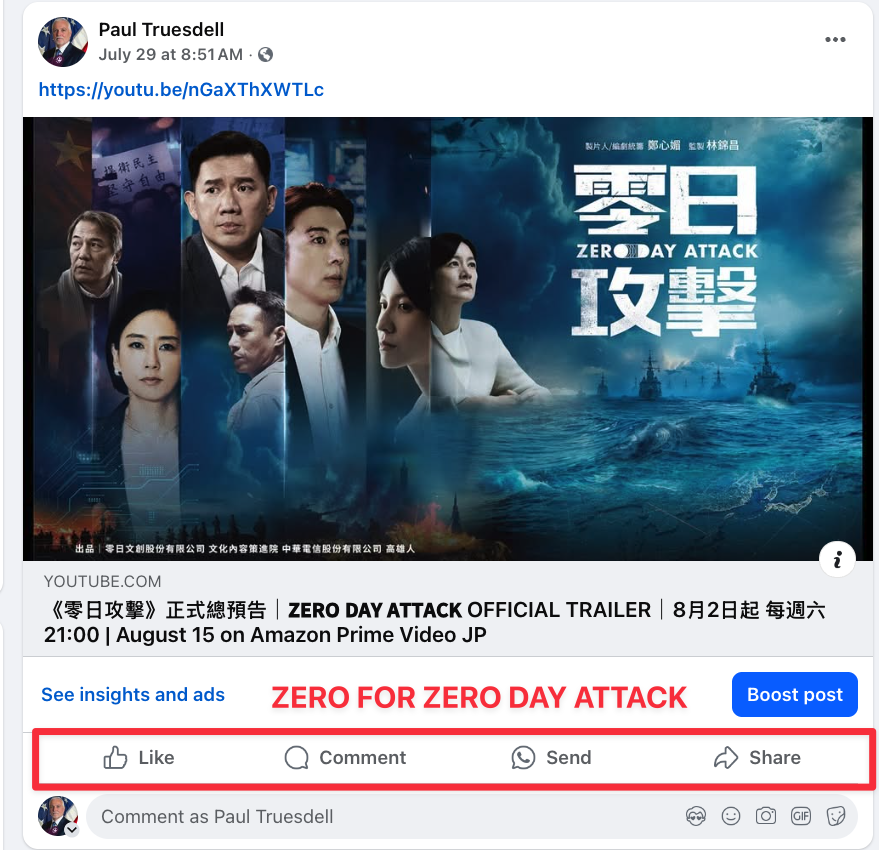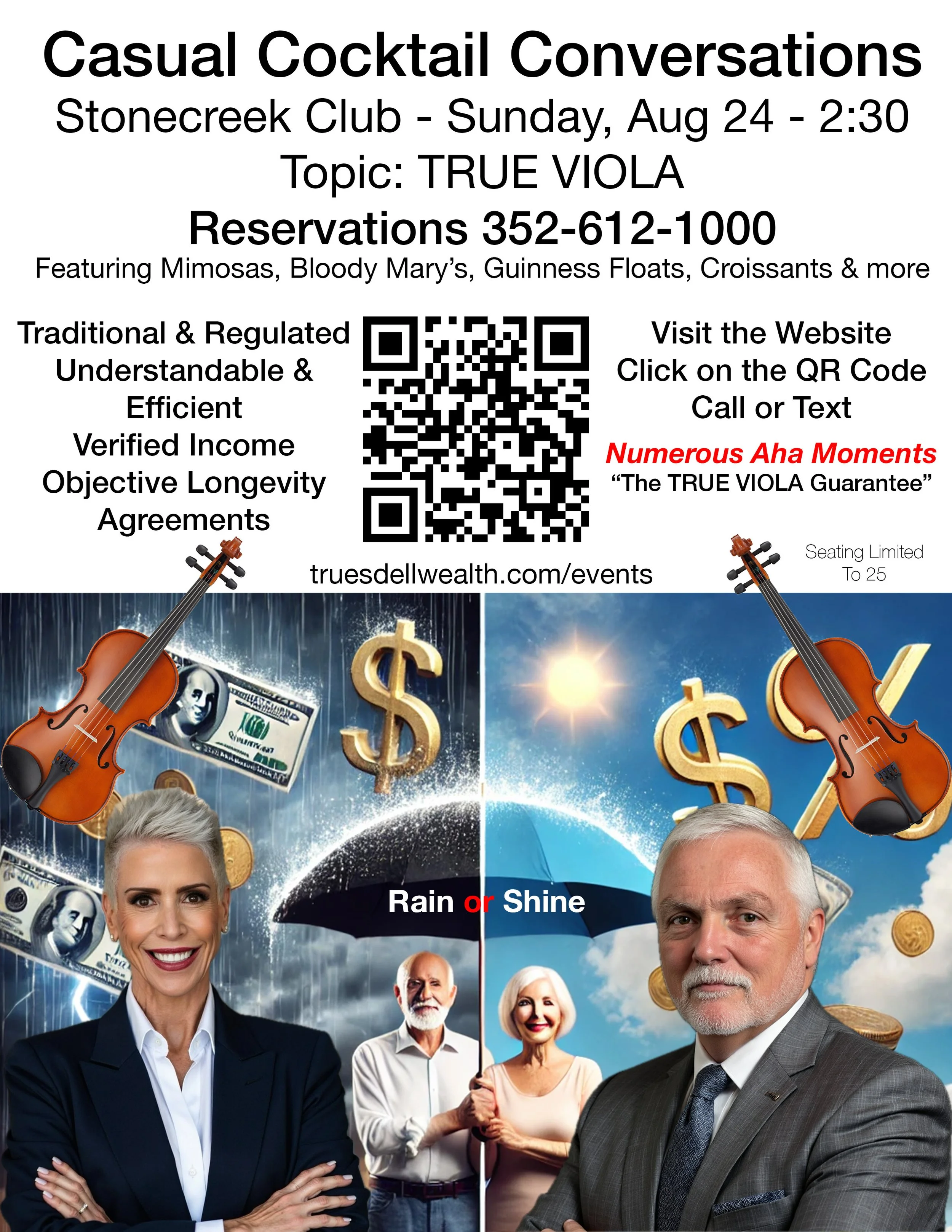Zero Day - The Facebook Post Thud
“Zero Day” and the Subtle Art of Mass Conditioning: A Closer Look at Propaganda, Programming, and Predictive Media
When I posted a trailer for “Zero Day Attack”—a seemingly obscure release scheduled for August 15 on Amazon Prime Video Japan—I said nothing. No caption. No commentary. No context. I let it sit in silence. Why? Because I wanted to see who, if anyone, would connect the dots.
No one did. And that tells you everything you need to know about the current state of social media—and our collective attention span.
1. The Dopamine-Driven Decay of Thought
Facebook, Instagram, TikTok, and all the rest were engineered to stimulate the brain's reward center. They are not platforms for deep thought. They are digital slot machines. You scroll. You like. You comment. You get a short-term hit of dopamine. Then you move on, never thinking critically about what you just consumed.
When Facebook first emerged, I tried to use it as a tool for thoughtful engagement. I shared long-form ideas, research, and commentary. That did not go over well. In fact, a former law enforcement colleague—a canine officer I never respected—criticized me publicly on Facebook for being “too wordy.” He said, “No one reads that stuff.” I promptly blocked him and never looked back. The irony? He was right about the platform—but dead wrong about the value of critical thought.
2. Testing the Waters with Visual Balloons
When I post something online, I am rarely posting for validation. I am often floating what I call “visual balloons.” Sometimes it is a news clip. Sometimes it is a movie trailer. Sometimes it is a meme, a chart, or a personal quote. What I am really doing is testing the water—seeing what sticks, what sparks curiosity, and what prompts deeper thought.
“Zero Day Attack” was one of those balloons.
At first glance, it appears to be just another action-thriller. But the timing is suspicious. The theme—cyber warfare, nation-state conflict, and digital sabotage—aligns too neatly with recent headlines and geopolitical tensions. This is not a coincidence. It is conditioning.
3. Media Is Not a Mirror—It Is a Megaphone
Think about the movies and shows that dominate the cultural landscape right before major events.
Before the COVID-19 pandemic, Contagion mysteriously resurfaced and began trending. During the climate change push, we were flooded with films about floods, fires, and frozen earth. Miami was supposed to be underwater by now. Spoiler alert: it is not.
I recently spoke with a couple who moved from Miami to a retirement community in Ocala. We laughed about how they managed to escape the fictional “rising sea levels.” They rolled their eyes. Because they understood that much of this was theatrics.
This is not to say that climate, disease, or cyber threats are not real. But the way they are presented—timed with military precision, saturated across media platforms, and marketed with emotional manipulation—should raise red flags. Hollywood is not an innocent storyteller. It is a strategic amplifier.
4. Behavioral Engineering Through Entertainment
When Top Gun was released, Navy recruitment spiked. When Maverick hit theaters decades later, interest in aviation and military service rose again. Now, with Apple producing a Formula One film starring Brad Pitt, expect a surge in F1 ticket sales, streaming views, and sponsorship revenue.
These productions are not accidental. They are investments. They are polished, packaged, and positioned to shape behavior—military enlistment, brand loyalty, political sentiment, even support for future war efforts.
So when I see a sudden media campaign that centers around Taiwan, cyber warfare, or digital infrastructure sabotage, I pay attention. Because the question is no longer if China will invade Taiwan—it is when. And the propaganda machine is already laying the groundwork to shape how the public will feel when it happens.
5. Who Funds the Frame?
Every movie has backers. Every film has a motive. Every storyline has a beneficiary.
Consider the saturation of football-themed movies: The Blind Side, Remember the Titans, Friday Night Lights, The Longest Yard, Draft Day, Any Given Sunday. There is always a “message”—overcoming adversity, patriotism, teamwork—but the subtext is crystal clear: football is business. These films feed the pipeline of players, viewers, consumers, and corporate partners.
The same logic applies to geopolitical films. If you see a surge in content focusing on military readiness, Asian conflict zones, or cyberattacks, ask yourself: who benefits from this narrative? Defense contractors? Intelligence agencies? Political candidates preparing the public for war?
6. Taiwan: The Elephant in the Theater
It is mind-boggling that Taiwan—a sovereign, democratic, technologically advanced island—still lacks formal recognition by most of the Western world. With the exception of Paraguay, virtually no North or South American nations recognize Taiwan as an independent country. Why? Because they fear upsetting the People's Republic of China.
Let me be blunt. China is a hostile, authoritarian regime. It is a surveillance state, a global polluter, and a manipulator of financial systems. And yet we continue to treat them like fragile glass—tiptoeing around trade, diplomacy, and military alliances.
If Donald Trump wanted to take a bold stand, one that would truly shift the balance of global power, he would immediately recognize Taiwan as a sovereign nation. Let China rattle sabers. Let them throw tantrums. Enough coddling.
7. Storylines as Soft Launches for Reality
We often forget that culture is upstream from policy. Before people accept something politically, they must accept it emotionally. They must be prepped. And the best way to prep them is through narrative.
If you want a population to support increased military budgets, you flood the airwaves with war stories. If you want them to tolerate surveillance and censorship, you make films about preventing cyberterror. If you want to normalize a confrontation with China, you start planting seeds in the form of “fictional” stories about Chinese aggression.
Zero Day Attack may be fiction—but its timing is strategic.
8. Connecting the Dots Is Not Conspiracy
This is not about paranoia. It is about pattern recognition.
It is about understanding that entertainment is often the first stage of political rehearsal. Movies, shows, trailers, and promotional posters are not just content—they are cues. And those cues are being placed, packaged, and promoted with precision.
I do not expect everyone to pick up on this. Most people are too distracted, too medicated, too overloaded with scrolling dopamine to notice the slow boil of predictive programming.
But for those who are paying attention, for those who have not yet surrendered their common sense to the algorithm, the patterns are there. You simply have to look.
Final Thoughts: It Was Never Just a Trailer
So, back to the trailer.
I posted it without explanation to observe the reaction—or lack thereof. Not one comment. Not one like. And that confirmed my suspicion: most people will not engage unless you spoon-feed them the meaning.
But life does not always give you context. Sometimes you have to investigate. Sometimes you have to ask: Why now? Why this story? Who profits?
That is the difference between being an informed citizen and a passive consumer. And in the coming months—when the headlines get louder, when the stakes get higher—you are going to wish you asked those questions sooner.
Afterword: The Art and Science of Knowing What Matters
Let me begin as I always do—with the truth. As an investment and wealth advisor who conducts quantitative analysis as well or better than 95 to 99 percent of professionals in this industry, I take great pride in the numbers. But let us be honest: numbers alone are not enough. The reality is that deep, meaningful, qualitative analysis takes far more time and effort—and that is where real opportunity often lives.
For those who live and die by spreadsheets, charts, and models—especially the do-it-yourself crowd—I will tell you this: you may be overlooking the most valuable decisions of your life. Not because you are unskilled, but because you are unbalanced. Greatness, whether in investing or in living, is not just science—it is art. It is not just logic—it is instinct. Those who build multi-generational wealth, who do more than simply retire comfortably, have one thing in common: they know how to think with both sides of the brain. They blend reason with intuition, data with discernment, timing with tone.
Most people do not want that level of complexity. And that is perfectly fine. A steady life and a dignified retirement are admirable goals. But for those who aim higher, know this: success will always come to those who understand the power of mixing qualitative insight with quantitative rigor. Even the most promising idea, product, or strategy will fail if no one wants it. And in today's world, testing those ideas has become harder than ever. The tools we used to trust—polls, focus groups, open feedback—are less reliable in an age where attention is gamed and opinions are shallow.
Now we watch where people’s eyes linger. Algorithms track our clicks, and artificial intelligence catalogs our interests. But the danger in this is obvious: the market rewards the lowest common denominator. Memes, dog videos, digital junk food—this is what drives the numbers. And yet, for those of us who still value nuance, who appreciate baseball, deep conversation, real insight, and meaningful context—there is a growing gap. We are profiled, labeled, sorted, and too often dismissed.
So yes, I know I am swimming upstream. I know when I test ideas, I throw them out in the wind just to see which way it blows. Sometimes it lands. Sometimes it vanishes. But this is the cost of qualitative thinking in a quantitative world. And perhaps that has always been the challenge—finding the balance. Seeing both the forest and the trees.
That is the art and science of life. And I am still practicing it every day.


